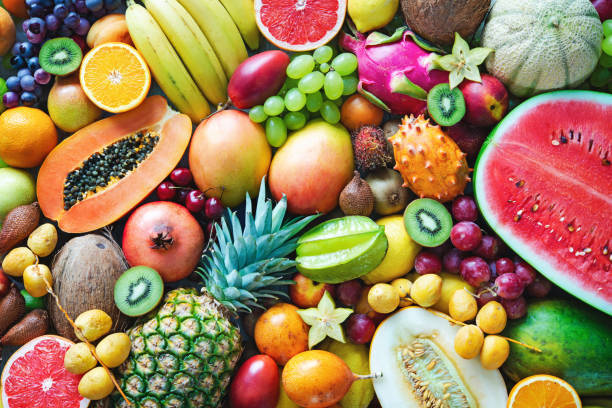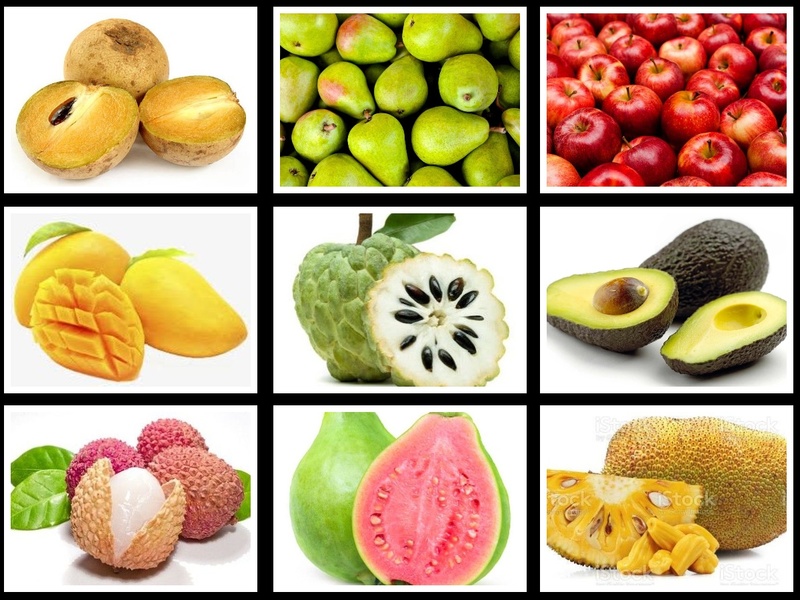In Addition
Vol 13 సంచిక 6
November / December 2022
Health tips
Relish fruits of every season for health!
“The right food is essentially satvic (calming). Milk, fruits, nuts, and so forth we understand to be satvic food… that has a subtle aspect to it which sustains and really strengthens us. Orange, tomato, lemon, and apple juices are very good for health…Quantity is very important, eg, eating two bananas is enough. If you eat four, it becomes tamasic (induces lethargy)”…Sathya Sai Baba1
1. Prelude
A comprehensive health article on fruits in general along with dos and don’ts was published in the newsletter vol 10 #3, May-June 2019. The present article dwells into their individuality and variety.
Seasonal fruits are fresh and tasty as they naturally ripen to reach their wholesome taste, flavour, and nutritional richness. This makes them healthy and affordable. Most of them are rich in 
 antioxidants (compounds which counter the unstable chemicals called free radicals in the body and protect the cells), especially vitamins C & E, carotenoids, and some essential minerals. They contain natural sugars, are low on the glycaemic index, aid digestion, cognitive faculty, cardiovascular health, endocrine system, diabetes management (when taken in small quantities), and boost immunity, skin and bone health. They are anti-inflammatory, maintain the body’s fluid balance, and prevent many diseases.2-5
antioxidants (compounds which counter the unstable chemicals called free radicals in the body and protect the cells), especially vitamins C & E, carotenoids, and some essential minerals. They contain natural sugars, are low on the glycaemic index, aid digestion, cognitive faculty, cardiovascular health, endocrine system, diabetes management (when taken in small quantities), and boost immunity, skin and bone health. They are anti-inflammatory, maintain the body’s fluid balance, and prevent many diseases.2-5
They have been broadly grouped as autumn/winter and spring/summer fruits, though some are available in other seasons too due to various factors. Well-known Hindi names of some fruits are given in italics within parentheses.
2. All-season fruits
2.1 Apple (Seb): A high-fibre, gut and heart-friendly fruit is a great source of cancer-fighting antioxidants; also, a natural remedy for asthma and diabetes. It is sweeter in autumn.6
2.2 Banana and Papaya have been covered extensively in earlier articles vol 3 #6 & #4 respectively; also refer to vol 2 #3 & #4 for articles on juices and smoothies for health.
3. Autumn and Winter fruits
3.1 Citrus fruits are rich in vitamin C and folate. They include orange (santara), sweet lime (mausambi) available through spring, kinnow (with high juice content), mandarin and tangerine (smaller and sweeter), clementine (small, often seedless, loved by children), kumquat (tiny citrus fruit that can be consumed with its sweet and nutritive skin, though its pulp has a sweet and tart flavour), pomelo (largest citrus fruit popular in China), persimmon (native to Asia), grapefruit, bitter orange, and lemon (nimbu) available in all seasons go well with salads and cooked lentils.5,7
3.2 Cranberries: Mostly carbs and fibre, rich in antioxidants mainly on its skin, it is 90% water and excellent to keep heart, teeth, and gut healthy; its juice can prevent urinary tract infection. Being sour rarely eaten raw, one can have diluted juice in limited quantity or combine it with apple juice. Not recommended for those having kidney stones or on blood thinners.8
3.3 Grapes (Angoor): The red and green grapes with their seeds can revitalize the body, prevent constipation, piles, and menstrual problems. Excess intake can cause hyperacidity.9,10
3.4 Guava (Amrud) has vitamin C four times of that in orange, can cure scurvy, prevent constipation, strengthen the endocrine system, especially thyroid, and effectively manage diabetes. Excessive consumption of guava seeds may lead to appendicitis.11,12
3.5 Kiwi (Chinese gooseberry) appears fuzzy like Kiwi bird but has tangy and sweet seedy green flesh inside. One small kiwi can meet more than 100% of vitamin C daily requirement, it acts as a natural remedy for improving digestion, sleep, and cellular health.5,13
3.6 Pears (Naspati/Babbugosha): Mildly flavoured sweet fruit, its pulp helps in removing blemishes on skin.14
3.7 Pomegranate (Anaar): A sweet-tart fruit with a thick red skin encasing hundreds of juicy seeds. It can prevent and treat several types of cancer, cardiovascular disease, osteo and rheumatoid arthritis, protect the brain, aid in wound healing, oral health, strengthen the reproductive system, and reduce oxidative stress in type 2 diabetic patients.5,15,16
3.8 Sapota (Chiku): A sweet fruit with soft and easily digestible pulp full of natural sugars, it is an instant source of energy. High in vitamin A, it promotes eyesight. Its leaves can heal mouth ulcers. Its seeds, dried and powdered, when applied to the scalp can get rid of dandruff and head lice.17
3.9 Star fruit/Carambola is a highly nutritious tropical fruit with a flavour similar to plum and apple.18
4. Spring and Summer fruits
4.1 Apricot (Khubani): A rich source of energy, vitamins, minerals and malic & citric acids, it detoxifies, regenerates body fluids, and is excellent for eye health; used in traditional medicine for cough, constipation, and asthma. Excess intake of raw apricot kernels can create health problems.19
4.2 Avocado: A super fruit, excellent for digestive health and heart. You can buy either a ripe fruit (difficult to get sometimes) or a firm one and allow it to ripen in a paper bag over several days. Avoid if you are advised low potassium diet for kidney health.20
4.3 Berries: Most popular is sweet blueberries with higher antioxidants good for memory and cognition; blackberries rich in vitamin K, for bone and heart health and to protect against stomach ulcers; raspberries low sugar, high fibre and rich in vitamin C, to help manage diabetes. Others include boysenberries, goji berries rich in vitamin A, acai berries, mulberries, and highly aromatic passion fruit, a type of berry.21-27
4.4 Cherries are sweet and juicy, can boost cognitive function, improve sleep quality, treat gout, and prevent macular degeneration and glaucoma. Most popular variety is heart-shaped bing cherries with a sweet lingering taste. Anyone with chronic kidney disease should avoid cherries. 28,29
4.5 Custard apple (Sita phal/Sharifa): A rainy season fruit with green scaly leather-like skin containing numerous black seeds encased in white juicy edible flesh with a creamy custard-like texture. It cools and maintains water balance by removing acids in the body. Rich in vitamin B & C, and magnesium, it can control diarrhoea and prevent anaemia, joints pain, fatigue and acne, and help with diabetes. Its inedible seeds when ground can be applied to get rid of dandruff and lice. Some popular varieties are cherimoya, mountain soursop, pawpaw (common in US and Canada), and sugar apple.30-33
4.6 Dragon fruit (Pitaya/Kamalam): Rich in antioxidants and high in fibre, this exotic fruit with a vibrant red scaly outer and seed speckled pulp with a mild sweet flavour has omega-3 fatty acids. A cross between kiwi, pear, and watermelon, its paste is used in treating acne and sunburn.34,35
4.7 Fig (Anjir) is a unique fruit filled with edible tiny seeds with a mild sweet taste. It can normalise many bodily functions damaged by diabetes. Fresh figs are easily perishable and are dried and preserved to reap their multiple benefits that increase after drying (refer newsletter vol 11 #1 on dry fruits). Fig leaves are used to prevent aging and to treat skin cancer.36
4.8 Jack fruit (Katahal): World’s largest tree fruit, exotic, with a subtle sweet and fruity flavour, it can give an instant energy boost, reduce the risk of osteoporosis, cure anaemia, and prevent diabetic complications. Choose a ripe one, recognised by its musky fragrance and softened spikes on the yellowish skin or wait for the green ones to ripen. A look-alike sweet and nutritious fruit known to be the most foul-smelling fruit in the world is Durian, harvested in some Southeast Asian countries.37-39
4.9 Lychee (Litchi): Mildly sweet, juicy, and pulpy, it hydrates, energises, and boosts immunity. Rambutan and mangosteen are other closely related fruits.40
4.10 Mango (Aam): The king of fruits, it is rich in variety and taste, juicy, and nourishing with a typical golden yellow flesh. High in vitamin A, B6, C & E and folate, it is a health booster and one of the best brain foods; can regulate blood pressure being rich in both potassium and magnesium and low in sodium. It is used in traditional medicine to strengthen digestion, build up body fluids, and ease coughing.41
4.11 Peach (Aadu) is a gut and heart-friendly delicious fruit with fuzzy skin, has bioactive compounds that can fight and eliminate candida. Closely related are nectarines with smoother skin and green & black fleshy olives rich in vitamin E.42-44
4.12 Pineapple (Ananas): This nutrient-rich tropical fruit has protein-digesting enzymes, especially bromelain (an anti-inflammatory and anti-swelling agent found mostly in the stem of the plant) which makes it a medicine for the body. When applied topically it helps in treating acne, cuts, burns, and insect bites. Juice from unripe fruit can cause diarrhoea and vomiting.45,46
4.13 Plum (Alubukhara): One of the best natural constipation remedies, it promotes bowel regulation, cardiovascular and cognitive health, and stabilises blood sugar level. Black plum (Jamun) can also treat blood disorders.47,48
4.14 Strawberry is not a berry but an aggregate fruit (flower with many ovaries appearing as small seeds from outside). A powerhouse of various antioxidants and vitamin C, it can prevent and combat diseases. Choose organically grown strawberries bright to deep red in colour with a fragrant sweet odour. Being easily perishable, eat when fresh, refrigerate unwashed to prolong their freshness.49
4.15 Watermelon (Tarbuj) is full of small black edible seeds rich in amino acids, especially both omega-3 & 6 fatty acids. The perfect treat to quench one’s thirst in summer, it keeps the body cool, hydrated, and healthy. The seeds can also be sprouted and shelled to maximise its health benefits. Its close cousin is melon (Kharbuja) with the two most beneficial varieties, cantaloupe having high vitamin A & C content and honeydew (sweetest of all melons) with a distinct aroma. Eating large amounts may spike blood sugar levels.50,51
5. Caution
Some people may have digestive distress with fruits, especially when taken in larger quantities, due to their FODMAP content (fermentable short-chain carbs that are absorbed poorly by the small intestine). Those with irritable bowel syndrome (IBS) or similar intestinal issues should avoid eating those with high FODMAPs content, e.g, apples, cherries, mango, nectarines, peaches, pears, plums, and watermelon.52
6. Last word!
Joy lies in the moderate intake of fruits, understanding the need and response of the body! Those with medical issues should consult their physician or nutritionist. “Live in each season as it passes: breathe the air, drink the drink, taste the seasonal fruit”…Henry David Thoreau.53
References and Links
- Sathya Sai Baba speaks on Food, page 10,43,62,63,65,66.
- https://www.health.harvard.edu/staying-healthy/understanding-antioxidants
- https://www.hsph.harvard.edu/nutritionsource/antioxidants/
- https://draxe.com/nutrition/summer-fruits/
- https://draxe.com/nutrition/winter-fruits/
- Apple: https://draxe.com/nutrition/apple-nutrition/
- Citrus fruits: http://www.walkthroughindia.com/nursery/top-15-varieties-of-citrus-fruits-available-in-india/
- Cranberries: https://health.clevelandclinic.org/benefits-of-cranberries/
- Grapes: https://www.1mg.com/ayurveda/grapes-121
- https://www.healthline.com/nutrition/benefits-of-grapes#
- Guava: https://drlogy.com/food-facts/fruits/guava-11-marvellous-health-benefits-important-facts
- https://www.1mg.com/ayurveda/guava-110
- Kiwi: https://www.healthifyme.com/blog/kiwi-fruit-benefits/
- Pears: https://www.1mg.com/ayurveda/pear-140
- Pomegranates: https://www.ncbi.nlm.nih.gov/pmc/articles/PMC4007340/#:~:text=Pomegranate
- https://pubmed.ncbi.nlm.nih.gov/23684435/
- Sapota: https://www.netmeds.com/health-library/post/sapodilla-sapota-health-benefits-nutrition-uses-recipes-and-side-effects#
- Star fruit: https://draxe.com/nutrition/star-fruit/
- Apricot: https://pharmeasy.in/blog/ayurveda-uses-benefits-side-effects-of-apricot/
- Avocado: https://draxe.com/nutrition/avocado-benefits/
- Berries: https://draxe.com/nutrition/health-benefits-blueberries/
- https://draxe.com/nutrition/health-benefits-blackberries/
- https://draxe.com/nutrition/raspberry-nutrition/ https://draxe.com/nutrition/boysenberry/
- https://draxe.com/nutrition/goji-berry-benefits/
- https://draxe.com/nutrition/acai-berry/
- https://draxe.com/nutrition/mulberry/
- https://draxe.com/nutrition/passion-fruit/
- Cherries: https://draxe.com/nutrition/benefits-of-cherries/
- https://www.healthifyme.com/blog/benefits-of-cherries/
- Custard apple: https://www.1mg.com/ayurveda/custard-apple-124
- https://bebodywise.com/blog/custard-apple-benefits/
- https://draxe.com/nutrition/cherimoya-fruit/
- https://draxe.com/nutrition/pawpaw-fruit/
- Dragon fruit: https://food.ndtv.com/food-drinks/7-dragon-fruit-benefits-the-antioxidant-vitamin-powerhouse-1247454
- https://www.medicinenet.com/can_i_eat_dragon_fruit_every_day/article.htm
- Figs: https://draxe.com/nutrition/figs-nutrition/
- Jackfruit: https://draxe.com/nutrition/jackfruit/
- https://www.healthifyme.com/blog/jackfruit/
- Durian: https://draxe.com/nutrition/durian-fruit/
- Lychee: https://draxe.com/nutrition/lychee/
- Mango: https://draxe.com/nutrition/mango-nutrition/
- Peach: https://draxe.com/nutrition/peach-nutrition/
- Olive: https://draxe.com/nutrition/olives-nutrition/
- Nectarines: https://www.healthline.com/nutrition/nectarine-vs-peach#basics
- Pineapple: https://draxe.com/nutrition/benefits-of-pineapple/
- https://www.drugs.com/npc/pineapple.html
- Plum: https://draxe.com/nutrition/plum-benefits/
- Black plum/Jamun: https://www.getatoz.com/content/10-health-benefits-of-black-plum/2476
- Strawberry: https://draxe.com/nutrition/strawberry-nutrition/
- Watermelon: https://draxe.com/nutrition/benefits-of-watermelon/
- Cantaloupe & Honeydew: https://draxe.com/nutrition/honeydew/#Honeydew_vs_Cantaloupe
- FODMAP: https://draxe.com/nutrition/fodmaps/
- American naturalist, poet, and philosopher and author (19th century) known for his famous book “Walden”, a reflection upon simple living in natural surroundings.
2. Anecdotes
1. Animals’ rapid response to Vibro11634…India
The practitioner treated his neighbour’s 7-year-old pet, a golden retriever named Jimmy who was suffering from severe backache, stomach pain and fever. He became so weak that he was unable to turn on his side and could not even get up. The dog was given CC1.1 Animal tonic + CC9.2 Infections acute + CC12.1 Adult tonic…one dose every 10 minutes for 2 hours. Worried, in case it is a hip disease leading to lameness, the owner considered visiting the vet. The next morning on seeing there was a substantial improvement, the owner decided to continue with just the vibro remedy. As the fever had subsided and the dog was able to get up but found it difficult to stand on his hind legs the remedy was suitably enhanced. The next day he was able to stand up comfortably on four legs but vomited everything he ate and had no appetite. With a new remedy for indigestion, vomiting stopped and appetite returned the very next day, much to the relief of his owner.
The same practitioner’s neighbourhood security guard found an abandoned calf that was about two months old. The calf was extremely weak, did not make any bleating sounds and was not able to stand on its legs, and even had to be fed by hand. On 1 Apr 2022, the calf was given CC1.1 Animal tonic + CC10.1 Emergencies + CC12.2 Child tonic. There were immediate signs of improvement and within three weeks, to everyone’s surprise and joy, the calf was able to move around and eat on its own and also started making low bleating sounds. As of October, the calf has grown healthy and strong, makes loud bleating sounds that are heard all over the neighbourhood and has been adopted as a pet by the entire residential community!

2. Rejuvenation of dormant plant 11641…India
Fascinated by the beautiful rose-purple trumpet flowers of the Allamanda blanchetti (Purple Allamanda) plant outside the Chaitanya Jyoti museum in Puttaparthi, this would-be practitioner procured a sapling and carefully potted it at home. Sadly, even after three long months of caring attention, it remained dormant, neither growing nor flowering as expected. Discouraged, she was on the verge of losing hope but then remembered many encouraging plant cases in the vibrionics newsletter. She eagerly awaited getting her 108CC Box. On 4 Aug 2022, she started treating with CC1.2 Plant tonic. Over the next week, the plant grew only slightly. So the practitioner added CC10.1 Emergencies + CC15.1 Mental & Emotional tonic to the above remedy. Three weeks into the treatment, the plant gained height but did not flower; so the remedy was further enhanced by adding CC8.1 Female tonic. To the practitioner’s surprise and delight, within a week the plant developed four buds and several new branches. After just over a total of one month, the plant’s first bud bloomed into a beautiful flower and the other buds followed suit. For the newly qualified practitioner, this personal experience was indeed gratifying!

3. Camps & Clinics
Regular camps in Puttaparthi
A vibrionics camp was started on a weekend in August 2022 in a nearby village Karnatakanagapalli across the Chitravati river at the request of a satisfied patient. Three camps have been held so far over three months and 78 patients have been treated. In addition, CC12.2 Child tonic + CC17.3 Brain & Memory tonic is distributed to young children. Practitioner11604 took the lead in making  arrangements, was joined by three practitioners11624, 2742, 11602 who attended in rotation. In view of the tremendous response, a spacious place is being arranged in a nearby school for the comfort of future patients.
arrangements, was joined by three practitioners11624, 2742, 11602 who attended in rotation. In view of the tremendous response, a spacious place is being arranged in a nearby school for the comfort of future patients.
With the initiative of Practitioner11624 and supported by Practitioners11604 & 03518 yet another camp was held in Puttaparthi at a Balvikas venue in Janakiramayya Colony opposite the Super specialty hospital in Prasantigram on 11 Sept 2022 (see pic). Before starting the consultations, a brief awareness talk on vibrionics was given to all those gathered. 58 patients, from a six-month-old baby to a 72-year-old adult, were treated for various ailments, with respiratory allergy being the one predominant condition. The Balvikas teachers helped with the patient registration and seating. All the 28 children were also given IB with CC17.3 Brain & Memory tonic added to it. As the camp was hugely appreciated by the locals, it will now become a regular feature.
4. In Memoriam
Revekka Kekou 02305…Greece left her earthly abode due to heart failure on 28 July 2022 at the age of 65, with Swami’s Prema Vahini under her pillow. She worked as a high school Headmistress in an underprivileged area of Greece where she touched the lives of many of her students with her kindness and compassion and became a mother to children with no parents, or those abused or addicted. She obtained her SRHVP in 2001 and 108CC box in 2013 and combined her vibrionics practice with her seva activities with the children. The human values she exemplified will always be remembered!
HS Narayan Murthy 11018…India 67, passed away due to a heart attack on 24 Aug 2022. He was working in a Sai school at Karwar, served as a Balvikas Guru, and participated in Sai Samithi activities. He was happy doing vibrionics seva to his friends and relatives and was ever willing to treat all referrals.
We offer our prayers for the departed souls.
